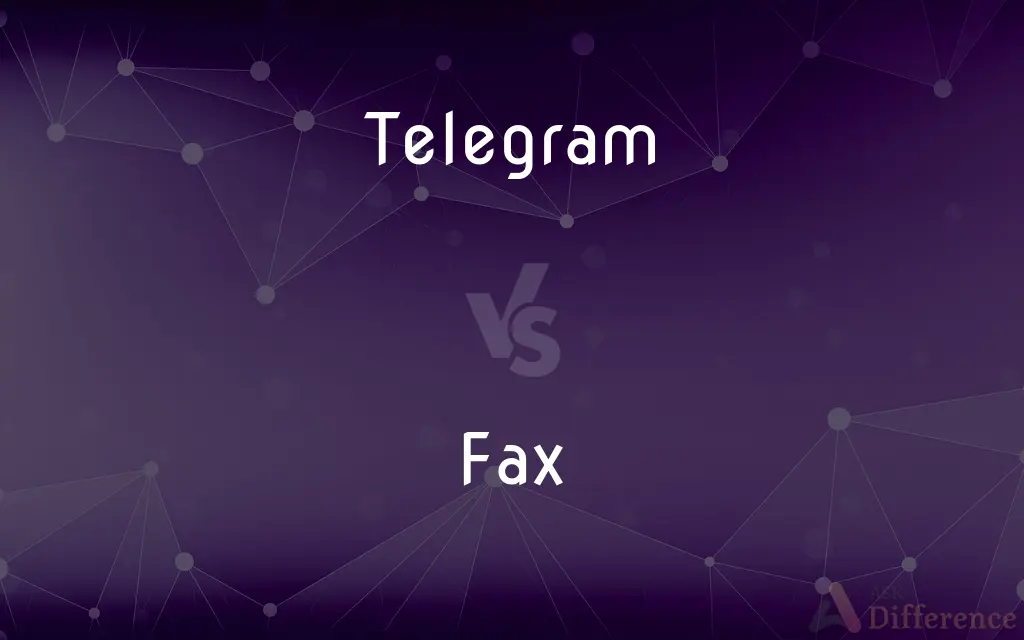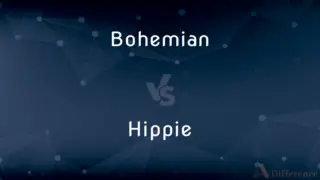Telegram vs. Fax — What's the Difference?
By Fiza Rafique & Urooj Arif — Updated on March 8, 2024
Telegram is a form of communication sending text messages via telegraph, emphasizing urgency, while fax involves transmitting scanned documents over a phone line, useful for legal documents.

Difference Between Telegram and Fax
Table of Contents
ADVERTISEMENT
Key Differences
Telegrams were historically significant for sending concise, urgent messages across long distances using telegraphy. They encoded text into electrical signals transmitted over wires, decoded at the receiving end. Faxes, on the other hand, transmit copies of documents (text or images) via telephone lines, directly from one machine to another, making them essential for sharing legal documents or contracts that require signatures.
The primary difference lies in their technology and usage context. Telegrams, now largely obsolete, were once the fastest way to communicate important messages internationally. Faxes, despite declining in popularity with the rise of email and digital communication, still hold relevance in certain business and legal contexts for their ability to transmit signed documents quickly.
Another key distinction is in their format and content. Telegrams typically contained only text, crafted to be as brief as possible due to cost considerations. Fax transmissions can include both text and images, allowing for the exact replication of original documents, including handwriting and signatures.
The usage and operational aspects also differ. Sending a telegram involved composing a message and having it transmitted by a telegraph operator. Sending a fax requires a fax machine or online fax service, where the document is scanned, converted into a bitmap, and sent through phone lines to the recipient's fax machine, where it's printed.
Today, the relevance of both technologies has diminished with the advent of faster, more versatile digital communication methods. However, faxes remain in use for specific applications where a physical copy or a document with a handwritten signature is necessary, while telegrams have transitioned more into a novelty or historical curiosity.
ADVERTISEMENT
Comparison Chart
Technology
Electrical signals sent via telegraph.
Scanned documents transmitted over phone lines.
Primary Use
Urgent text messages.
Transmitting scanned documents, especially legal ones.
Content
Text only, with a focus on brevity.
Text and images, including signatures.
Format
Encoded messages decoded at receiving end.
Exact replication of original documents.
Operational Aspect
Composed and transmitted by operators.
Scanned and sent/received by fax machines.
Current Relevance
Largely obsolete, replaced by digital communication.
Still used for specific legal and business documents.
Compare with Definitions
Telegram
Encoded text into electrical signals.
The telegraph operator encoded the message into a telegram.
Fax
Transmits scans of documents over phone lines.
The contract was sent to the client via fax for a quick signature.
Telegram
Now a novelty or for historical interest.
He collected old telegrams as a hobby.
Fax
Remains relevant for specific applications.
Despite digital alternatives, many lawyers still use fax for certain documents.
Telegram
Emphasized brevity due to cost.
The telegram contained only the most crucial information.
Fax
Can include both text and images.
The fax included a signed letter and a diagram.
Telegram
A method of sending messages via telegraph.
The urgent news was quickly sent via telegram.
Fax
Used for legal documents requiring signatures.
Legal documents were often exchanged through fax for their immediacy.
Telegram
Historically significant for international communication.
During the war, families communicated via telegrams.
Fax
Operational through a fax machine or service.
The office kept a dedicated line for the fax machine.
Telegram
A message transmitted by telegraph.
Fax
Fax (short for facsimile), sometimes called telecopying or telefax (the latter short for telefacsimile), is the telephonic transmission of scanned printed material (both text and images), normally to a telephone number connected to a printer or other output device. The original document is scanned with a fax machine (or a telecopier), which processes the contents (text or images) as a single fixed graphic image, converting it into a bitmap, and then transmitting it through the telephone system in the form of audio-frequency tones.
Telegram
To telegraph (something) or be telegraphed.
Fax
A fax machine.
Telegram
A message transmitted by telegraph.
Fax
A document transmitted or received by a fax machine. In both senses also called facsimile.
Telegram
(intransitive) To send a telegram.
Fax
To transmit (a document) by a fax machine.
Telegram
(transitive) To send a telegram to (a person).
Fax
The hair of the head.
Telegram
(transitive) To send (a message) in a telegram.
Fax
Senseid|en|machine}} {{ellipsis of fax machine
Telegram
A message sent by telegraph; a telegraphic dispatch.
Fax
A document sent, or received and printed by a fax machine
Telegram
A message transmitted by telegraph
Fax
To send a document via a fax machine.
Fax
Alt form of facts.
Fax
Duplicator that transmits the copy by wire or radio
Fax
Send something via a facsimile machine;
Can you fax me the report right away?
Common Curiosities
What has replaced telegrams in modern communication?
Emails, instant messaging, and other forms of digital communication have largely replaced telegrams, offering faster and more versatile communication options.
Can you send a fax without a fax machine?
Yes, you can send a fax without a physical fax machine using online fax services that allow you to send and receive faxes via email or a web application.
Why do some businesses still use fax machines?
Some businesses still use fax machines for their ability to send documents that require signatures or for compliance with regulations that mandate the use of fax for certain communications.
Why were telegrams considered urgent?
Telegrams were considered urgent because they were the fastest way to send concise messages over long distances before the advent of faster digital communication.
Was there a limit to the length of a telegram?
While there was no strict limit, telegrams were usually brief due to cost; charges were based on the number of words or characters.
Can telegrams be intercepted?
Historically, telegrams could be intercepted and decoded by unauthorized parties, which was a concern during times of war or in diplomatic communications.
How do digital signatures compare to faxed signatures?
Digital signatures are becoming widely accepted and have legal standing similar to faxed signatures, offering a secure and verifiable way to sign documents electronically.
Can faxes still be considered secure?
Faxes can be considered secure for transmitting sensitive documents, as they're less susceptible to hacking compared to email, making them preferred in legal and medical fields.
How does the cost of sending a fax compare to a telegram?
The cost of sending a fax generally depends on phone line charges and is usually less than the historical cost of sending a telegram, which was based on word count.
Are there any modern uses for telegram services?
Modern uses for telegram services are mostly ceremonial or nostalgic, such as sending a telegram for a special occasion or as a unique gift.
What technological advancements contributed to the decline of telegrams?
The advent of the internet, email, mobile phones, and instant messaging contributed significantly to the decline of telegrams by offering more efficient and versatile forms of communication.
What are the environmental impacts of using faxes?
The environmental impacts include paper usage and energy consumption of fax machines, though these are mitigated by digital or paperless fax solutions.
How did telegrams and faxes change business communication?
Telegrams and faxes revolutionized business communication by significantly reducing the time it took to send and receive important information and documents across distances.
Is there a quality difference between original documents and faxed copies?
Yes, faxed copies can suffer from quality degradation, especially if the original document is of poor quality or the fax machine's resolution is low.
What legal validity do faxed documents have?
Faxed documents are legally binding in many jurisdictions, especially when both parties recognize the fax as a valid method of communication and document exchange.
Share Your Discovery

Previous Comparison
Bohemian vs. Hippie
Next Comparison
Venture vs. StartupAuthor Spotlight
Written by
Fiza RafiqueFiza Rafique is a skilled content writer at AskDifference.com, where she meticulously refines and enhances written pieces. Drawing from her vast editorial expertise, Fiza ensures clarity, accuracy, and precision in every article. Passionate about language, she continually seeks to elevate the quality of content for readers worldwide.
Co-written by
Urooj ArifUrooj is a skilled content writer at Ask Difference, known for her exceptional ability to simplify complex topics into engaging and informative content. With a passion for research and a flair for clear, concise writing, she consistently delivers articles that resonate with our diverse audience.
















































